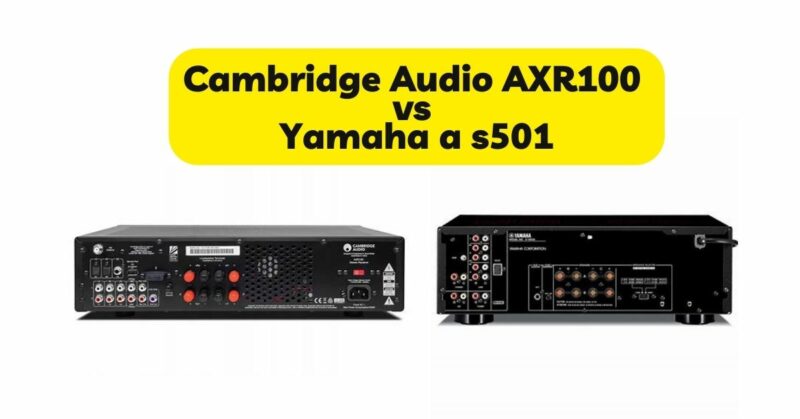Cambridge Audio and Yamaha are reputable brands known for their commitment to producing high-quality audio equipment. In this article, we will compare two popular models: the Cambridge Audio AXR100 and the Yamaha A-S501. Both amplifiers offer impressive performance, versatile features, and a solid reputation among audiophiles. By examining their key specifications, sound performance, connectivity options, and overall user experience, we aim to help you make an informed decision when choosing between the Cambridge Audio AXR100 and the Yamaha A-S501.
Key Specifications : The Cambridge Audio AXR100 and Yamaha A-S501 are both integrated amplifiers designed to deliver excellent sound quality and performance.
The AXR100 offers a power output of 100 watts per channel into 8 ohms, while the A-S501 provides 85 watts per channel into 8 ohms. The AXR100’s higher power output may be advantageous for driving demanding speakers or for those seeking higher volume levels with less strain on the amplifier.
Both amplifiers feature high-quality construction and components. The AXR100 incorporates Cambridge Audio’s meticulous attention to detail, while the A-S501 showcases Yamaha’s renowned craftsmanship and build quality.
Sound Performance : The Cambridge Audio AXR100 and Yamaha A-S501 deliver impressive sound quality, but they have distinct sonic characteristics.
The AXR100 emphasizes clean and transparent sound reproduction. It offers a neutral tonal balance with excellent clarity and detail retrieval. The amplifier excels at reproducing the subtle nuances and dynamics of music, providing an accurate and engaging listening experience. It maintains control over the audio signal, resulting in precise instrument separation and a well-defined soundstage.
On the other hand, the Yamaha A-S501 offers a warmer and more musical sound signature. It provides a slightly richer and more expressive presentation, adding a touch of warmth and smoothness to the audio. The amplifier exhibits a balanced tonal balance, allowing for an engaging and enjoyable listening experience. It offers a wide soundstage and good instrument placement, immersing the listener in the music.
Connectivity and Features : Both the Cambridge Audio AXR100 and Yamaha A-S501 provide a range of connectivity options and features to enhance the user experience.
The AXR100 offers versatile connectivity with multiple analog inputs, allowing for the connection of various audio sources such as CD players, turntables, and media players. It also includes a built-in phono stage, specifically designed for moving magnet (MM) cartridges, catering to vinyl enthusiasts. Additionally, the AXR100 features Bluetooth connectivity, enabling convenient wireless streaming from compatible devices.
Similarly, the A-S501 offers multiple analog inputs, accommodating different audio sources. It includes a built-in phono stage, supporting both moving magnet (MM) and moving coil (MC) cartridges. The A-S501 also provides digital inputs, including optical and coaxial, allowing for connection to digital audio sources. Additionally, it features a subwoofer output, providing the option to enhance the low-frequency performance of the audio system.
Both amplifiers include tone controls, enabling adjustments to bass and treble levels according to personal preferences. However, it’s worth noting that the AXR100 offers more precise control over the tone settings, allowing for a greater degree of customization.
Build Quality and Design : The Cambridge Audio AXR100 and Yamaha A-S501 exhibit solid build quality and thoughtful design.
The AXR100 features a sleek and modern design, with a clean front panel and intuitive controls. The amplifier’s build quality is impressive, with attention to detail and sturdy construction. The AXR100’s aesthetics are understated and timeless, ensuring it can seamlessly integrate into any audio setup.
The A-S501 embraces a classic design, with a vintage-inspired aesthetic and retro control knobs. The amplifier is well-built, showcasing Yamaha’s commitment to craftsmanship and durability. The A-S501’s design exudes a sense of elegance and sophistication, making it a visually appealing addition to any audio system.
Conclusion : Choosing between the Cambridge Audio AXR100 and Yamaha A-S501 depends on your personal preferences and specific requirements. The AXR100 offers clean and transparent sound reproduction, providing excellent detail retrieval and accuracy. The A-S501, on the other hand, delivers a warmer and more musical sound, adding a touch of richness and immersion.
Both amplifiers offer versatile connectivity options, including built-in phono stages for turntable connectivity. The AXR100 provides Bluetooth connectivity, while the A-S501 offers digital inputs for expanded audio source options.
Consider factors such as your preferred sound signature, connectivity needs, and aesthetic preferences when making your decision. By evaluating the key specifications, sound performance, connectivity options, and overall design of the Cambridge Audio AXR100 and Yamaha A-S501, you can select the amplifier that best suits your audio preferences and enhances your listening experience.

